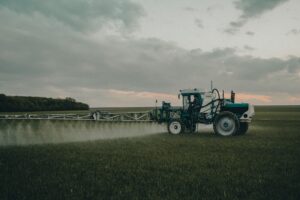Pesticides
By their very nature, most pesticides create some risk of harm to humans, animals, or the environment because they are designed to kill or otherwise adversely affect living organisms.
What are Pesticides?
(From the EPA Office of Pesticide Programs)
A pesticide is any substance or mixture of substances intended for preventing, destroying, repelling, or mitigating any pest. Pests can be insects, mice and other animals, unwanted plants (weeds), fungi, or microorganisms like bacteria and viruses. Though often misunderstood to refer only to insecticides, the term pesticide also applies to herbicides, fungicides, and various other substances used to control pests.

Under United States law, a pesticide is also any substance or mixture of substances intended for use as a plant regulator, defoliant, or desiccant. Many household products are pesticides. Did you know that all of these common products are considered pesticides?
- Cockroach sprays and baits
- Insect repellents for personal use.
- Rat and other rodent poisons.
- Flea and tick sprays, powders, and pet collars.
- Kitchen, laundry, and bath disinfectants and sanitizers.
- Products that kill mold and mildew.
- Some lawn and garden products, such as weed killers.
- Some swimming pool chemicals.
By their very nature, most pesticides create some risk of harm to humans, animals, or the environment because they are designed to kill or otherwise adversely affect living organisms. At the same time, pesticides are useful to society because of their ability to kill potential disease-causing organisms and control insects, weeds, and other pests. In the United States, the Office of Pesticide Programs of the Environmental Protection Agency is chiefly responsible for regulating pesticides. Biologically-based pesticides, such as pheromones and microbial pesticides, are becoming increasingly popular and often are safer than traditional chemical pesticides.
Here are some common kinds of pesticides and their function:
Algicides
- Control algae in lakes, canals, swimming pools, water tanks, and other sites.
Antifouling agents
- Kill or repel organisms that attach to underwater surfaces, such as boat bottoms.
Antimicrobials
- Kill microorganisms (such as bacteria and viruses).
Attractants
- Attract pests (for example, to lure an insect or rodent to a trap). (However, food is not considered a pesticide when used as an attractant.)
Biocides
- Kill microorganisms.
Disinfectants and sanitizers
- Kill or inactivate disease-producing microorganisms on inanimate objects.
Fungicides
- Kill fungi (including blights, mildews, molds, and rusts).
Fumigants
- Produce gas or vapor intended to destroy pests in buildings or soil.
Herbicides
- Kill weeds and other plants that grow where they are not wanted.
Insecticides
- Kill insects and other arthropods.
Miticides (also called acaricides)
- Kill mites that feed on plants and animals.
Microbial pesticides
- Microorganisms that kill, inhibit, or out compete pests, including insects or other microorganisms.
Molluscicides
- Kill snails and slugs.
Nematicides
- Kill nematodes (microscopic, worm-like organisms that feed on plant roots).
Ovicides
- Kill eggs of insects and mites.
Pheromones
- Biochemicals used to disrupt the mating behavior of insects.
Repellents
- Repel pests, including insects (such as mosquitoes) and birds.
Rodenticides
- Control mice and other rodents.
The term pesticide also includes these substances:
- Defoliants Cause leaves or other foliage to drop from a plant, usually to facilitate harvest.
- Desiccants Promote drying of living tissues, such as unwanted plant tops. I
- nsect growth regulators Disrupt the molting, maturity from pupal stage to adult, or other life processes of insects.
- Plant growth regulators Substances (excluding fertilizers or other plant nutrients) that alter the expected growth, flowering, or reproduction rate of plants.
Health Effects of Pesticides
Acute health effects of pesticide exposure:
- Eye, nose, and throat irritation (rashes, burning, blisters)
- Nausea
- Dizziness
- Diarrhea
- People with asthma can have more severe reactions
Long-term health effects of pesticide exposure:
- Cancer and other tumors
- Damage to brain and nervous system
- Birth defects
- Damage to kidney, lungs, and other organs
- Infertility and reproductive problems
Children can be most vulnerable to pesticide toxicity. They have a higher chance of being in contact with pesticides due to their high respiratory rate, proportionately larger food and water intake, and increased contact with floors, lawns, and playgrounds. Children also still have developing organs, nervous systems and immune systems. Because everything is still developing, exposure to pesticides can cause permanent damage. To learn more visit Californians For Pesticide Reform- Pesticides and Human Health page
Farm Workers are often exposed to pesticides. They have little to no protection, and because many are undocumented, they are less likely to seek medical care.
Preventing worker illness from indoor pesticide exposure– Although we often think about farming and agriculture when we hear about pesticides, we also must consider workers in indoor settings who may become ill from indoor pesticide use. Learn the exposure risks faced by workers exposed to pesticides indoors, how to safely manage pests in the office, and what kinds of pesticides are safer to use in indoor settings. (From the Occupational Health Branch of the California Department of Public Health).
